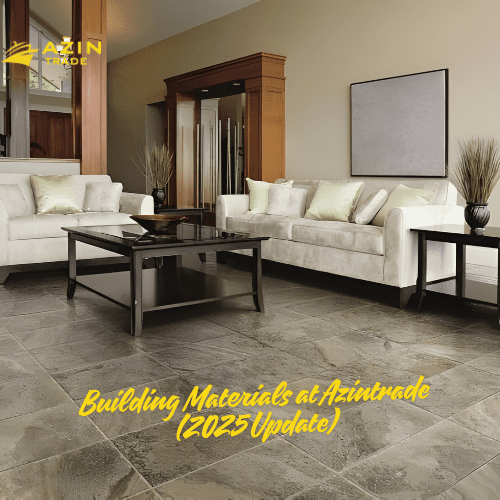Ceramic vs Porcelain Tiles: Key Differences, Uses, and Export Insights
When it comes to flooring, wall coverings, and construction materials, ceramic and porcelain tiles dominate the market. Both options are popular for residential, commercial, and export projects, but they differ significantly in material, durability, appearance, maintenance, and cost.
Understanding these differences is essential for architects, interior designers, contractors, and exporters who want to provide high-quality, durable, and visually appealing solutions to clients worldwide.
This comprehensive guide will help you choose the right tile for your project, compare features, and explore export opportunities.
1. Material and Manufacturing Differences
Ceramic Tiles
-
Made from natural clay, usually red or white, mixed with minerals.
-
Fired at lower temperatures, resulting in slightly porous and softer tiles.
-
Easy to cut, shape, and install, making them ideal for interior walls and decorative applications.
-
Often glazed for color and protection, which also provides a wide variety of design options.
Porcelain Tiles
-
Produced from refined, denser clay with very fine particles.
-
Fired at higher temperatures, creating tiles that are denser, harder, and less porous.
-
Perfect for floors, high-traffic areas, outdoor installations, and export-quality products.
-
Can be glazed or unglazed, often designed to mimic natural stone, marble, or wood textures.
Key Takeaway: Porcelain tiles are stronger, more water-resistant, and more durable, while ceramic tiles are lighter, more versatile for decoration, and easier to install indoors.
2. Durability and Strength
| Feature | Ceramic Tile | Porcelain Tile |
|---|---|---|
| Water Absorption | Higher | Very Low (<0.5%) |
| Resistance to Scratches | Moderate | High |
| Suitability for Heavy Traffic | Limited | Excellent |
| Longevity | Good | Superior |
| Resistance to Stains | Moderate | Excellent |
| Frost Resistance | Poor | Excellent |
Practical Advice:
-
Use ceramic tiles for interior walls, low-traffic areas, bathrooms, and kitchens.
-
Use porcelain tiles for floors, outdoor patios, high-traffic zones, commercial spaces, and export projects.
3. Appearance, Design, and Finishing Options
-
Ceramic Tiles:
-
Vibrant colors and intricate patterns.
-
Glazed finishes provide shine and easy cleaning.
-
Great for bathrooms, backsplashes, and decorative walls.
-
-
Porcelain Tiles:
-
Often mimic natural materials such as stone, marble, and wood.
-
Can be matte or polished, providing a luxurious and natural aesthetic.
-
Works well in both indoor and outdoor spaces, maintaining color and quality over time.
-
Tip for Designers: Combining ceramic and porcelain in the same project can create visual contrast, using porcelain for durability and ceramic for decorative elements.
4. Price and Investment Considerations
| Type | Average Cost | Longevity | Value for Money |
|---|---|---|---|
| Ceramic | Lower | Moderate | Budget-friendly option |
| Porcelain | Higher | High | Long-term investment |
-
Ceramic tiles are generally cheaper and ideal for small-scale or decorative projects.
-
Porcelain tiles are more expensive due to refined material, dense structure, and durability, but they are a smart long-term investment, especially for high-traffic or export projects.
For exporters, porcelain tiles offer higher perceived quality and command better prices in international markets.
5. Applications and Use Cases
Ceramic Tiles
-
Wall coverings (bathrooms, kitchens, living rooms)
-
Decorative accents, mosaics, and backsplashes
-
Low-traffic interior flooring
-
Budget-friendly renovation projects
Porcelain Tiles
-
Commercial and residential floors with heavy foot traffic
-
Outdoor patios, terraces, and facades
-
Export-oriented projects requiring durable and premium quality
-
Areas prone to moisture, frost, or wear and tear
Pro Tip for Exporters: Highlight porcelain tiles’ resistance to moisture, scratches, and outdoor conditions in catalogs and product descriptions to attract international buyers.

6. Advantages and Limitations
| Feature | Ceramic Tiles | Porcelain Tiles |
|---|---|---|
| Durability | Moderate | Excellent |
| Maintenance | Easy | Very Easy |
| Cost | Lower | Higher |
| Aesthetic Variety | High | High, premium finish |
| Water Resistance | Moderate | Very High |
| Installation | Easy | Requires professional precision |
Tips:
-
Choose ceramic tiles for decorative or indoor-only projects.
-
Choose porcelain tiles for floors, outdoor areas, or export projects.
-
Always verify technical specifications, thickness, and porosity for long-term durability.
7. Quick Comparison Table
| Feature | Ceramic Tiles | Porcelain Tiles | Key Point |
|---|---|---|---|
| Material | Regular clay | Fine, dense clay | Porcelain is stronger and less water-absorbent |
| Density & Strength | Moderate | High | Ideal for floors and high-traffic areas |
| Primary Uses | Interior walls, decorative | Floors, outdoor, export projects | Choice depends on project type |
| Appearance & Design | Colorful, glazed | Natural, stone/wood look | Porcelain has a premium look |
| Price | Lower | Higher | Porcelain is a long-term investment |
8. Tips for Buyers and Users
-
For interior decorative use, ceramic tiles are sufficient.
-
For durable, water-resistant, and export-quality projects, porcelain is the best choice.
-
Pay attention to thickness, porosity, and type of glazing when purchasing.
-
For international shipments, check technical specifications and compliance with international standards.
-
Consider combining both tiles for visual contrast while balancing cost and durability.
Recommended CTA Links:
-
“Browse Our Ceramic Tiles Collection” → [Ceramic Tiles Product Page]
-
“Explore Premium Porcelain Tiles” → [Porcelain Tiles Product Page]
Image Suggestions:
-
Side-by-side ceramic vs porcelain tiles
-
Durability infographic showing water absorption and scratch resistance
-
Sample interior and exterior installation examples
ALT text Examples:
-
“Comparison of ceramic and porcelain tiles for interior and exterior use”
-
“Durability and design differences between porcelain and ceramic tiles”
Conclusion
Both ceramic and porcelain tiles have essential roles in construction, interior design, and export markets.
-
Ceramic tiles: budget-friendly, versatile, decorative, suitable for indoor use.
-
Porcelain tiles: durable, water-resistant, premium aesthetic, ideal for floors, outdoor projects, and exports.
By using clear comparisons, tables, actionable tips, and highlighting export potential, users and buyers can make informed decisions for their projects, ensuring both aesthetic appeal and long-term durability.
Contact us for more information :






